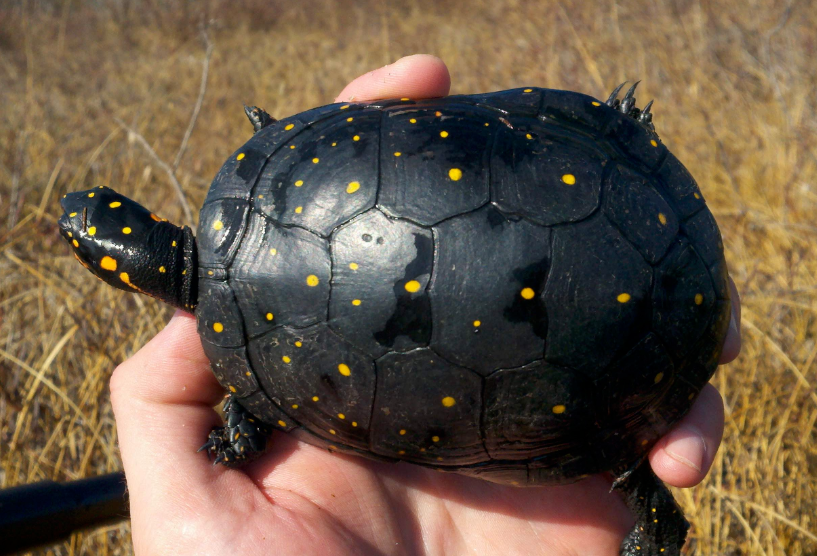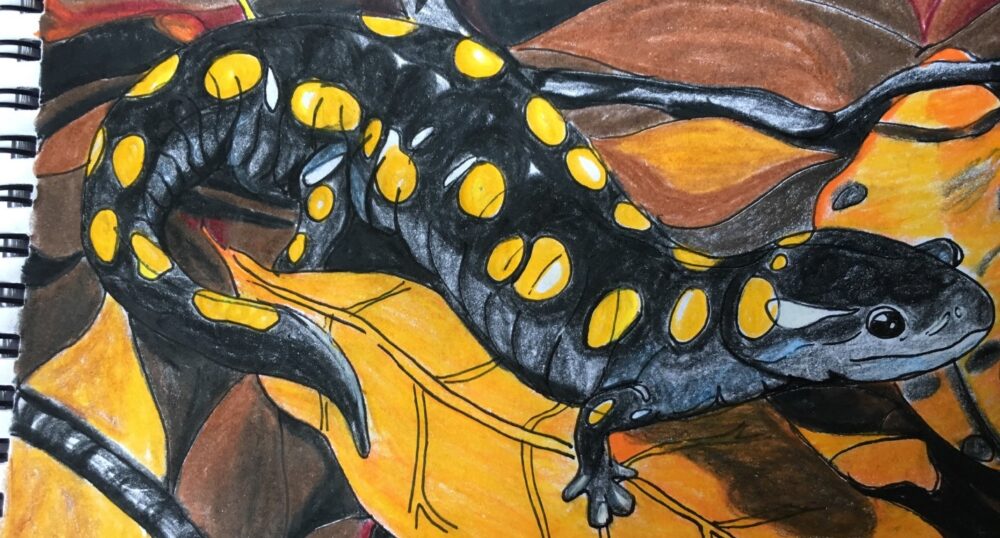By Rose Nixon
These adorable little critters are disappearing, and they need our help!

Warning! If you’re anything like me (a highly inquisitive yet highly distractible nature lover) you might soon find yourself in a spiral of searches about the small and adorable, Spotted Turtle (Clemmys guttata). After a series of searches myself, I soon learned that this long lived species is only found along the eastern US and Canada and is listed as globally endangered on the International Union for Conservation of Nature (IUCN) Red List. To find out more, I had a conversation with Hunter Howell, a PhD student at the University of Miami, about a paper on Spotted Turtles that he co-authored titled “Long-Term Turtle Declines: Protected Is a Verb, Not an Outcome” along with researchers Richard Legere Jr., David Holland, and Richard Seigel.
Hunter has had a lifelong love of working with turtles and got involved with this work after researchers who conducted a historic population study of Spotted Turtles in a protected area from 1987-1992 in Central Maryland asked for his teams help. The old researchers had historic data from this study but wanted to do something bigger for the hurting species…so a collaboration was born! The new research group set out to conduct an almost identical study of the two studied populations to see what had changed for the turtles in the past 30 years. Had their numbers grown? Shrank? Or was there something more they could find out about these little testudines? After doing a mixture of visual encounter surveys and trappings over four years, they found out an unsettling truth.
Even though these turtle populations live in a designated protected area, they had declined by almost 50% over the past 30 years. That may seem like a long time for animals fending for themselves against predators and in the elements, but 30 years is only about one generation length for Spotted Turtles, just the same as us. That’s not all: not only had their numbers dwindled but their age distribution had changed as well leaving the population older and with less younglings. This unbalanced age dynamic tells us that while the mature turtles are aging and eventually dying and leaving the population, the young ones aren’t entering in the first place. This creates somewhat of a generational gap and a less healthy overall population.
This spurred the research team to conduct a series of Population Viability Analyses (PVAs), a modeling tool conservation biologists frequently use to estimate the chance that a population will either persist or go extinct. They used both the historic and contemporary data and found the same trend: if business goes as usual, these populations that were booming not too long ago will be facing a 93-94% chance of quasi-extinction in the next 150 years. Even if these declines aren’t as dramatic as the PVA suggests, there is still a definite threat of these populations becoming non-viable—they may still exist, but they will hit a point of no return and shrink until they are locally extinct.
Bottom line: These turtles need our help
The biggest take away from Howell’s research is that even seemingly healthy populations of Spotted Turtles living in protected areas can be subject to serious declines. Turtles living in a protected area may be shielded from certain forms of human caused mortality and habitat loss/fragmentation, but they can still be affected by a slew of anthropogenic factors if in an unmanaged area. Road mortality, introduced predators, habitat succession, invasive species, and poaching have and continue to severely affect the survivorship or reproductive output in these turtles and occur in protected areas that have been set aside and left without an active management plan.
Howell stressed that there is a need for a paradigm shift in turtle conservation from assuming a population is stable until proven it’s declining to the opposite. Because these turtles are so long-lived (up to 50-100 years) a population that is declining can persist for decades or even centuries without disappearing yet lose the window for replenishing its members. Basically: just because they’re there doesn’t mean they have a viable population…it means they are there in spite of not being viable.
For a little humor-based clarity: imagine you just bought a big tub of ice-cream (aka our turtle population) and are saving it as a treat for later. You know that it will last for a very long time in the freezer and don’t have any worries of it disappearing or going bad quickly (long lived species). However, your roommate has been slowly sneaking a few bites here and there unbeknownst to you, until you pick up the carton one day and it’s basically empty (anthropogenic factors chipping away at our population). From an outsider’s perspective it looks like a full tub of ice-cream but in reality, it is only a shell of its past state (seemingly okay population but has seriously declined). This is unfortunately the case for many turtle species, they are on a long slow decline to extinction…no crash, no sudden disappearance, but instead a slow extinction vortex that may go unnoticed before it’s too late.
To make matters worse, the effects of climate change and sea level rise are going to have a significant effect on coastal Spotted Turtle communities. Howell spoke to his and other’s research in Maryland and explained that we are on track for a sea level rise that would extirpate the largest populations from state. This means that all of the sites from Howell’s study and 4 others on eastern shore will be completely underwater.
So What?
These are a long-lived species and due to lack of recruitment in the younger age classes, this population is set to age out and disappear for good. Because this is a globally endangered species, conservation of any population is crucial especially for ones seen in the study where management actions could potentially reverse the direction of the trends.
What’s next? Is there hope?
The short answer is yes! But with conditions. The bright side to this pretty depressing reality is that there is time to act because of how long this species lives and their use of a variety of habitats. Howell told me that we have decades to isolate factors of decline, but that doesn’t let us off the hook. There is the ongoing problem of getting people to get to care about and act on climate change which will ultimately shape the success of this species and countless others globally. If sites like the ones studied by Howell are actively managed and aren’t left to their own devices, there is a chance of saving the Spotted Turtle.
After finishing this research, Howell told me that he and his team have gone out and done a variety of things to switch from passive to active management. In 2017 they installed an exclusion fence near the site along a road where turtles were being struck to prevent unnecessary road mortality. Between 2018 and 2019, the area was continually monitored for visual encounters of turtles and there have been no road kills! Howell explained that by reducing road mortality alone, they could keep the population basically stable or at least at a much, much slower decrease. They also did a series of tree girdling to open the canopy, as well as invasive species removal to better create the preferred healthy, early successional habitat for our little Clemmys companions. Howell’s goal is to go back to the site in 2023 and do a complete resampling of the turtles to see if any of these actions will have helped increase their survival. However, because of their large generational gaps, he said that they may not be able to see a difference then, but hopefully by 2030.
What can we do?
Unfortunately, there’s only a limited number of hands-on things that the public can do to help this species. Due to Spotted Turtle’s high attractiveness to poachers and fear of human encroachment/disturbance of prime habitat, researchers like Howell can’t give out specifics on locations of populations without risking having their numbers dive. But you can help them by participating in road surveys! This is especially important at high density road crossings and during certain times of the year such as spring when they are most active and most likely to be moving between wetlands, to upland nesting sites, and or across roads.
If road surveys aren’t your thing, consider getting in touch with and donating to your local wildlife society or one that is conducting research for the Spotted Turtle. In this study’s case it is the Susquehannock Wildlife Society (for Vermonters, the VT Herp Atlas!); any amount is meaningful towards assisting the many conservation programs that they carry out including the continuation of research and active management for threatened wildlife populations.
Lastly, we all need to keep the conversation going about climate change by educating ourselves and each other on the ways it is and will continue to affect us, the ecosystems around us, and the ones who don’t have ways of speaking up. Informing ourselves about the seriousness of a changing climate can be extremely disheartening but can also be powerful in the ways that information can be used to help others, including the Spotted Turtle whose fate depends on our actions. We have a chance at saving this species, so why don’t we give it our all?
Where can I find this paper/more information?
Hunter’s Website: https://hunterjhowell.wordpress.com/
Susquehannock Wildlife Society Page: http://www.susquehannockwildlife.org/
Spotted Turtle Info: https://www.iucnredlist.org/species/4968/97411228 & https://www.vtherpatlas.org/herp-species-in-vermont/clemmys-guttata/
